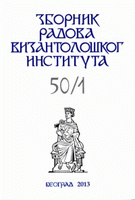ΑΓΙΟΣ ΓΕΩΡΓΙΟΣ Ο ΓΟΡΓΟΣ: Η ΑΛΛΗΓΟΡΙΚΗ ΕΡΜΗΝΕΙΑ ΣΤΗΝ ΕΝΝΟΙΟΛΟΓΙΚΗ ΜΕΤΑΛΛΑΞΗ ΤΟΥ ΕΠΙΘΕΤΟΥ
Saint George Gorg: Allegorical Interpretations In The Conceptual Changing Epithet
Author(s): Vasilis KacarosSubject(s): History
Published by: Vizantološki institut SANU
Keywords: Gorgos; St. George’s iconography; St. George and dragon; Nemanic; horseman saint
Summary/Abstract: he author of this article attempts to interpret the name “gorgos” associated with Saint George, utilizing data from the oldest tradition in conjunction with the historical environment in which revives the worship of the saint as equestrian Akrita warrior. The relationship of the rider hero with his warhorse raises the heroism of the military saints of the East, particularly of Cappadocia at a time when the bravery and the heroism of the lads of the Akritian circle is generally emerging. The combination akrita/soldier and farmer meets at the same person of Saint George, who later appears in the iconography, as protector of the water, highlighting the type of “dragonslayer”. As a formidable equestrian warrior, the Saint smites the enemies of Byzantium during the two wars that Constantine IX Monomachus conducts against the Patsinakoi, considering that Saint George stood fi rmly by his side. So George as “gorgos” warrior, is being adopted as the protector of the palace at whom the emperor dedicates the temple of the Mangana Palace. With the status of “protector” of the imperial house of Byzantium, Saint George becomes prostate symbol of the “royal house” and is being adopted in imitation, from the Serbian House of Nemanides, whose members lived in the environment of the capital of Byzantium and experienced customs and traditions of the Byzantine court and society. This explains the “transposition” of the worship of Saint George with the status of warrior – “gorgos” protector of Byzantium at the Serbian territory of the house of Nemanides and appears to resort in the monuments, accepting the great honor as “family saint protector” from the rulers of the dynasty that had multifarious relations with Byzantium.
Journal: Зборник радова Византолошког института
- Issue Year: 2013
- Issue No: 50/1
- Page Range: 505-519
- Page Count: 15
- Language: Greek, Modern (1453-)

